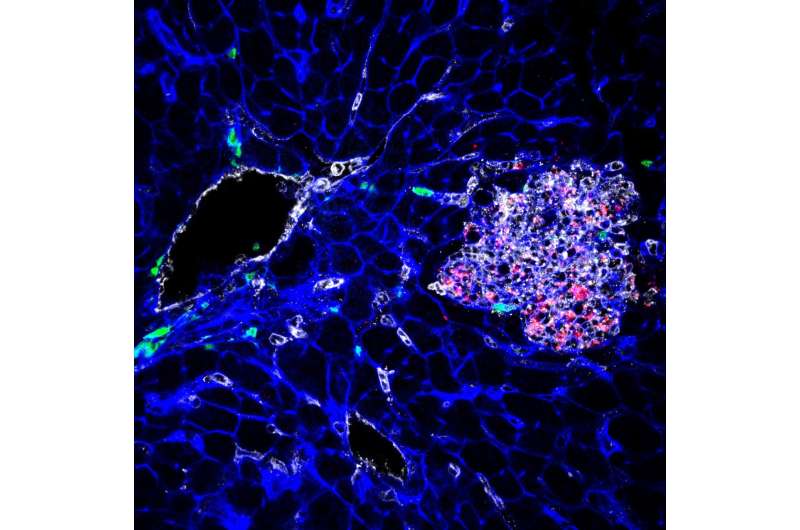Listeria monocytogenes (in red) infecting tissue cells. Credit: Institut Pasteur
A serious infection of dietary origin that is caused by the Listeria monocytogenes bacterium, listeriosis is associated with severe clinical symptoms and a high mortality rate in individuals with weakened immune systems. INRA scientists, working in collaboration with their colleagues at the Institut Pasteur, have demonstrated the novel capacity of L. monocytogenes to generate dormant intracellular forms that could be harboured, unsuspected, by hosts. These findings are published on Nov. 30, 2017 in PLoS Pathogens.
Listeriosis is a disease caused by eating foods that have been contaminated by the Listeria monocytogenes bacterium. It is a particular danger to individuals with impaired immune systems, the elderly and newborn infants. It also affects farmed livestock. The pathogenic potential of L. monocytogenesis is linked to its ability to invade different cells in the body, such as epithelial cells in the intestine, liver, brain and placenta. When it reaches the cytoplasm of these cells, L. monocytogenes proliferates and uses a network of cell filaments—called the cytoskeleton—to travel and spread into neighbouring cells. This phase enables L. monocytogenes to disseminate throughout the body's tissues.
In order to study the behaviour of L. monocytogenes during an asymptomatic infection, INRA scientists, working in collaboration with their colleagues at Institut Pasteur, created an original in vitro experimental model using cultures of human epithelial cells. Through this model, they discovered that L. monocytogenesis is able to change its lifestyle when it infects the cells of the liver and placenta for several days. The bacteria gradually stop producing the protein (ActA) that allows them to spread using the cytoskeleton of infected cells. They are then trapped in the vacuoles. In this intracellular niche, they are more tolerant of antibiotics and retain an ability to reactivate themselves in a form that can be disseminated.
These bacteria can also undetectably infect host cells during cell divisions. Although viable, the bacteria are thus in a non-cultivable physiological state.
These in vitro results have revealed the ability of L. monocytogenes to generate dormant intracellular forms which may be harboured, unsuspected, by humans or animals. The asymptomatic carriage of this pathogenic bacterium may explain why the incubation period for listeriosis is sometimes long (up to three months). It also offers a possible explanation for the problems encountered in identifying the source of contamination in the case of sporadic listeriosis, if the illness occurs a long time after the ingestion of contaminated food. It is possible that dormant forms of L. monocytogenes may thus reactivate themselves. This mechanism could also lead to healthy carriage of this pathogenic agent in animals that serve as a reservoir for the bacterium.
More information: Listeria monocytogenes switches from dissemination to persistence by adopting a vacuolar lifestyle in epithelial cells. Mounia Kortebi, Eliane Milohanic, Gabriel Mitchell, Christine Péchoux, Marie-Christine Prevost, Pascale Cossart and Hélène Bierne. PLoS Pathogens 13 (12):e1006734
Journal information: PLoS Pathogens
Provided by Institut Pasteur
























